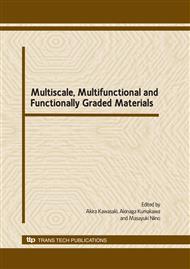p.187
p.193
p.199
p.205
p.211
p.217
p.225
p.231
p.239
Calcium Phosphate Coating on Blast-Treated Titanium Implants by RF Magnetron Sputtering
Abstract:
Calcium phosphate coating films were fabricated on Ti-6Al-4V plates and screw-type implants with a blast-treated surface using radiofrequency (RF) magnetron sputtering and were evaluated in vitro and in vivo. Amorphous calcium phosphate (ACP) and oxyapatite (OAp) films obtained in this study could cover the blast-treated substrate very efficiently, maintaining the surface roughness. For the in vitro evaluations of the calcium phosphate coating films, bonding strength and alkaline phosphatase (ALP) activity were examined. The bonding strength of the coating films to a blast-treated substrate exceeded 60 MPa, independent of film phases except for the film after post-heat-treatment in silica ampoule. When compared with an uncoated substrate, the increase in the ALP activity of osteoblastic SaOS-2 cells on a calcium phosphate coated substrate was confirmed by a cell culture test. The removal torque of screw-type Ti-6Al-4V implants with a blast-treated surface from the femur of Japanese white rabbit increased with the duration of implantation and it was statistically improved by coating an ACP film 2 weeks after implantation. The in vitro and in vivo studies suggested that the application of the sputtered ACP film as a coating on titanium implants was effective in improving their biocompatibility with bones.
Info:
Periodical:
Pages:
211-216
Citation:
Online since:
October 2009
Price:
Сopyright:
© 2010 Trans Tech Publications Ltd. All Rights Reserved
Share:
Citation:


